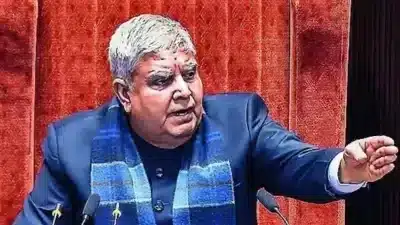About the Vice President of India
- Constitutional status: The Vice President holds the position of the second-highest constitutional office in India, after the President.
- Article 63 of the Constitution mandates the existence of the Vice President’s office.
- The Vice President of India serves a dual role, modelled on the lines of the American Vice President.
- Eligibility criteria: According to Article 66 of the Constitution, a person must meet the following conditions to be eligible for the office of Vice President:
- The candidate must be an Indian citizen.
- The individual must be at least 35 years of age.
- The candidate must be qualified to be elected as a member of the Rajya Sabha.
- The candidate must not hold any office of profit under the Union, state government, or any local or public authority.
Election Process
- The Vice President is elected through a proportional representation system by an electoral college that includes both elected and nominated members of the Lok Sabha and Rajya Sabha. This differs from the Presidential election process, which also includes state legislative assemblies.
- The election is conducted using a single transferable vote system, and voting is carried out by secret ballot.
- Any doubts or disputes regarding the election of the Vice President are adjudicated by the Supreme Court, and its decision is final.
Tenure and Removal
- Tenure: The Vice President serves a five-year term, starting from the date they assume office.
- The Vice President can continue in office until a successor takes charge, even after the completion of the term.
- The Vice President is eligible for re-election.
- Resignation: The Vice President can resign by submitting a formal resignation letter to the President of India.
- Removal process: According to Article 67(b), the Vice President can be removed through a resolution passed by the Rajya Sabha with an effective majority (majority of all the then members).
- This resolution must also be agreed to by the Lok Sabha with a simple majority.
- A 14-day notice is required before moving the resolution.
Q1: What is impeachment?
Impeachment is the process by which the President of India can be removed from office for “violation of the Constitution.” It is a quasi-judicial procedure initiated by Parliament, requiring a special majority in both Houses after thorough investigation and discussion.
News: TH
Last updated on June, 2025
→ UPSC Notification 2025 was released on 22nd January 2025.
→ UPSC Prelims Result 2025 is out now for the CSE held on 25 May 2025.
→ UPSC Prelims Question Paper 2025 and Unofficial Prelims Answer Key 2025 are available now.
→ UPSC Calendar 2026 is released on 15th May, 2025.
→ The UPSC Vacancy 2025 were released 1129, out of which 979 were for UPSC CSE and remaining 150 are for UPSC IFoS.
→ UPSC Mains 2025 will be conducted on 22nd August 2025.
→ UPSC Prelims 2026 will be conducted on 24th May, 2026 & UPSC Mains 2026 will be conducted on 21st August 2026.
→ The UPSC Selection Process is of 3 stages-Prelims, Mains and Interview.
→ UPSC Result 2024 is released with latest UPSC Marksheet 2024. Check Now!
→ UPSC Toppers List 2024 is released now. Shakti Dubey is UPSC AIR 1 2024 Topper.
→ Also check Best IAS Coaching in Delhi
Tags: Prelims Pointers upsc current affairs upsc prelims current affairs vice president removal






















